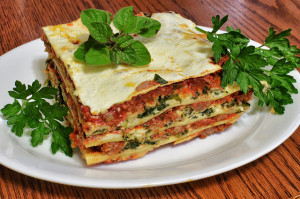The Lasagna Method of Writing


Mmm… lasagna by jefferyw via Flickr
Nope, I’m not done talking about the Faith Hunter Bait and Hook workshop I attended in August! I just took so much amazing stuff away from it that I can’t help but share the choice morsels. Today’s topic is the Lasagna Method, easily the most popular concept shared at When Words Collide this year after Hunter laid it out for us on Thursday.
To put it in context for you, the Lasagna Method concerns backstory. Whether it’s information about your character’s history or your world, less is always more, but you still have to fill in the gaps for your reader. Leaving them floundering in the dark is not an option, neither is boring them with endless info dumping. That’s where the Lasagna Method comes in.
To quote Hunter nearly verbatim: “Flashbacks, backstory, and history should take place from the character’s point of view in the last two-thirds of the book unless peppered in small pieces throughout the narrative. Why? Because these things don’t hook, bait, or help with conflict when they’re presented in big chunks.”
It’s like this:
Your protagonist’s history is the onion in the recipe;
Your world’s unique history is the tomato sauce;
Your supporting characters’ stories are the noodles;
Your protagonist’s significant flashbacks are the cheese;
And so on and so forth.
In the glass baking dish that is your story’s confines, you’re not going to just dump these different ingredients in big piles. That will lead to one nasty mess. The key to making a great lasagna is layering all the different ingredients in harmony and balance. The key to great story telling is layering all the different threads in harmony and balance.
It’s such a simple analogy that its mind blowing. I intend to do my utmost to follow the Lasagna Method when I write, I really should say when I edit, because it is such a great lesson.
What do you think?

The post The Lasagna Method of Writing appeared first on Anxiety Ink.
Anxiety Ink
- Kate Larking's profile
- 53 followers



